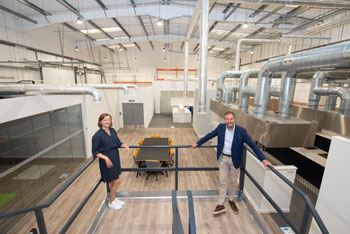
2020 brought a myriad of challenges and upsets – both business-related and personal – for everyone. Yet despite all of this, Hearst UK Chief Executive and Hearst Europe President James Wildman believes there’s never been a better time to work in publishing.
True, he readily admits to being a perennial optimist. But his view is not the result of rose-tinted glasses. Rather, it is underpinned by his firm belief in the innate strengths – and enduring potential – of magazines.
“The opportunities for our industry that lies ahead are associated with what magazines are all about,” he explains.
“At Hearst, we see our purpose being to help our consumers get more out of their lives. This is a purpose shared by all our brands, equally. It informs everything we do. And it enshrines the opportunity out there (for all publishers), because of the much-loved part magazines play in people’s lives.”
Wildman led a business turnaround – culminating in a return to top-line revenue growth in 2018 after several years of decline – after joining Hearst UK as CEO in 2017 from Trinity Mirror, where he was chief revenue officer. His previous roles include managing director and VP sales at Yahoo! UK & Ireland and managing director at Interactive Digital Sales after an earlier career in TV sales.
At Hearst, we see our purpose being to help our consumers get more out of their lives.
Business diversification
Key to this has been a focus on accelerating the business’s diversification and digital development, and also its cultural transformation – three things which have been especially challenging in a year dominated by Covid-19.
Much of what has been achieved since he arrived, Wildman insists, was “already work in progress”.
“What we did when I joined was put a strategic framework around it,” he explains.
“We are blessed because we have these 20-plus extraordinary, iconic brands (including ELLE, Good Housekeeping, Cosmopolitan, Women’s Health, Harper’s Bazaar and Esquire as well as digital-only titles such as Digital Spy) and the talent that produces content for them.
“It’s a matter of what new business (and businesses) we can spin out of that incredible foundation – in terms of talent and capability, what makes best sense.”
Over the past four years, four areas of activity have emerged as clearly defined businesses.
There is the Hearst Content Agency, which creates premium quality content for third party brands – the largest is Asda, for which Hearst handles all its social content, online cookery content, and a monthly magazine offered to every Asda customer which gives it a circulation of 1,787,333 (ABC Jul-Dec 2019) making it the largest circulating lifestyle magazine in the UK.
There is Hearst Licensing, too. This ranges from established licensed product lines spun out of its own brands, such as DFS’ Country Living Sofa, to new tie-ups – as with Homebase, which announced a partnership with Hearst UK to create new kitchen, home and garden ranges in October.
Then there are events, through Hearst Live. From Bazaar Woman of the Year to Red Smart Women Week, this business has grown rapidly and significantly. And though with the pandemic crisis forcing live event cancellations, it has also evolved most rapidly – into virtual versions, such as with its Country Living fairs, last year.

Finally, there is product testing and accreditation of third-party products. Firmly rooted in the long-standing Good Housekeeping Institute (GHI) based in Soho, this also involves a consultancy proposition which involves feeding back on product features to manufacturers. And it is now set for major expansion following Hearst’s decision last year to set up a far bigger facility in Feltham called The Hearst Institute to expand these activities. The move will see GHI endorsements that effectively drive retail sales across many product categories extended beyond Good Housekeeping to Hearst’s other brands.
Aside from these four business areas, revenue is also being driven by what spins out of Hearst’s own brands, Wildman adds.
“Things like ecommerce, which is enjoying really strong growth, and even advertising as it becomes more sophisticated. Though not diversification, all are developing and progressing as they become more data-informed, as video plays a greater role, and as they work more effectively with social platforms,” he explains.
Meanwhile, with Hearst still selling four million magazines a month in the UK, cover price remains important – as are subscriptions which, for some brands, jumped by up to 200% last year.
Traditional advertising is the more challenging side of the business, obviously.
“Advertising budgets are very much informed by two things: consumer confidence and GDP, and you couldn’t imagine a worse context for those two factors recently,” he continues.
“But the diversification of our revenues, and the more sophisticated approach there now is to advertising, has protected us to some extent. We are outperforming our marketplace quite significantly and as a result, we will keep pushing on.”
Creating marketing services that sit above the brands in its magazine stable is the way ahead for the business. Which is one reason why Wildman is fascinated by rival publisher Future’s £594m offer to buy comparison website GoCompare, announced shortly before we speak.
“It is a very big buy, of course,” he says. “But it is also a very interesting diversification – and vertical integration, too, because it is a media business saying what’s to buy aligning itself with a service that advises where to buy it.”
What we are building is a 360-degree solutions business rather than a traditional media company.
360-degree approach
Hearst UK’s approach is somewhat different, of course. But it is as committed as any publisher – if not more so – when it comes to evolving and future-proofing a diversified, content-driven business model.
“Accreditation, experiential, content creation, licensing are all important, all complementary. We also own (digital marketing agency) iCrossing, which we are integrating more and more into what we do – which gives us fantastic digital performance capabilities around search and social to add more value to our commercial partners,” Wildman continues.
“We’ve driven our own brands’ digital business and are now up to 28m unique monthly users in the UK – an incredible reach that throws out the most incredible data and insight which power our programmatic, our research and our insights capabilities. And it is all of this that is moving us forward and ensuring we have a highly future-facing and progressive business.
“What we are building is a 360-degree solutions business rather than a traditional media company.”
Digital will provide a major engine for further growth over the year ahead.
With more people at home with more time because of home working, digital audiences this year were up 20% and digital advertising is coming back strongly after a March to mid-year hiatus when a lot of campaigns were pulled, Wildman says.
Looking ahead, the demise of the third-party cookie (due in 2022) will put more emphasis and value on proprietary data.
“We’re not blasé or complacent,” he insists. “But we are confident in the trust and nature of our product and also our audiences: we are an absolutely safe haven for digital advertising investment and are very proud of that in terms of brand safety.”
We are an absolutely safe haven for digital advertising investment and are very proud of that in terms of brand safety.
Priorities for 2021
Between now and then, however, ecommerce and events will be among Hearst’s 2021 digital priorities.
“There is great potential to grow ecommerce due to changes in consumer behaviour,” Wildman continues.
“Magazine media has always influenced purchasing decisions in an extraordinary way. We super serve people’s passions and people act on our advice and trust the brands – and editors’ – view on things. Put that together with ecommerce – and the strength and reach of our brands and there is an enormous opportunity.”
True to its vision, the business launched Hearst Influencer Network last year in partnership with social media and talent agency Sixteenth to grow and develop the social footprint of Hearst talent – another string to its revenue diversification bow.
“It’s a mark of our recognition that our editors are the ultimate influencers and always have been, pre-dating social media,” he adds.
“What they write shifts product because it is trusted. We are now investing in developing our people’s social profiles – both for their own benefits and business benefits, to take to advertisers and around which to create interesting new business propositions.”
Necessity forced events to become part of Hearst’s digital business this year, of course. The first was Women’s Health Live back in May, which proved highly popular when lockdown prompted Hearst to turn it into a three-day festival of fitness at short notice. But it opened eyes to virtual events’ longer-term appeal to advertisers and so revenue potential.
Hearst’s annual festival of ideas Esquire Townhouse, for example, went digital this year when it took place in October and, re-named Esquire Townhouse at Your House, was ‘staged’ in partnership with Breitling.
All of which brings us back to why Wildman believes that despite the past bruising year, now is a good time to be in the publishing industry. Which has much to do with social media.
“Though there are many great things about digital, there are also some significant negatives – like the fragmentation of media, which advertisers have made a virtue of through microtargeting,” he believes.
“But as that’s happened, something has been lost, and that’s trust. And, moving forward, I think there is going to be an increasing gravitational pull towards tried and tested and trusted lighthouse brand such as ours.”
While certain media brands will flourish, a shakeout is inevitable, he predicts. Some will get stronger, others will fall away – those less strong, less trusted, less established.
“We’re not in any way complacent, but I feel strongly we are in a privileged position. And the opportunities this creates are closely associated with what magazines are all about,” Wildman observes.
“Our purpose at Hearst – to help our consumers get more out of life – is not forced, it’s authentic. It informs everything we do. And that enshrines the opportunity.”
Magazines still play a unique and much-loved part in people’s lives. And the most successful still have huge reach and scale. People don’t second screen when reading a magazine, so it is a really engaged experience, too. And digitally, the metrics of the biggest titles remain incredibly strong.
“Our content is trusted,” he adds. “And that’s the opportunity for the industry: the trusted nature of our products and the premium quality of our content.”
I think there is going to be an increasing gravitational pull towards tried and tested and trusted lighthouse brand such as ours.
This article was first published in InPublishing magazine. If you would like to be added to the free mailing list, please register here.










